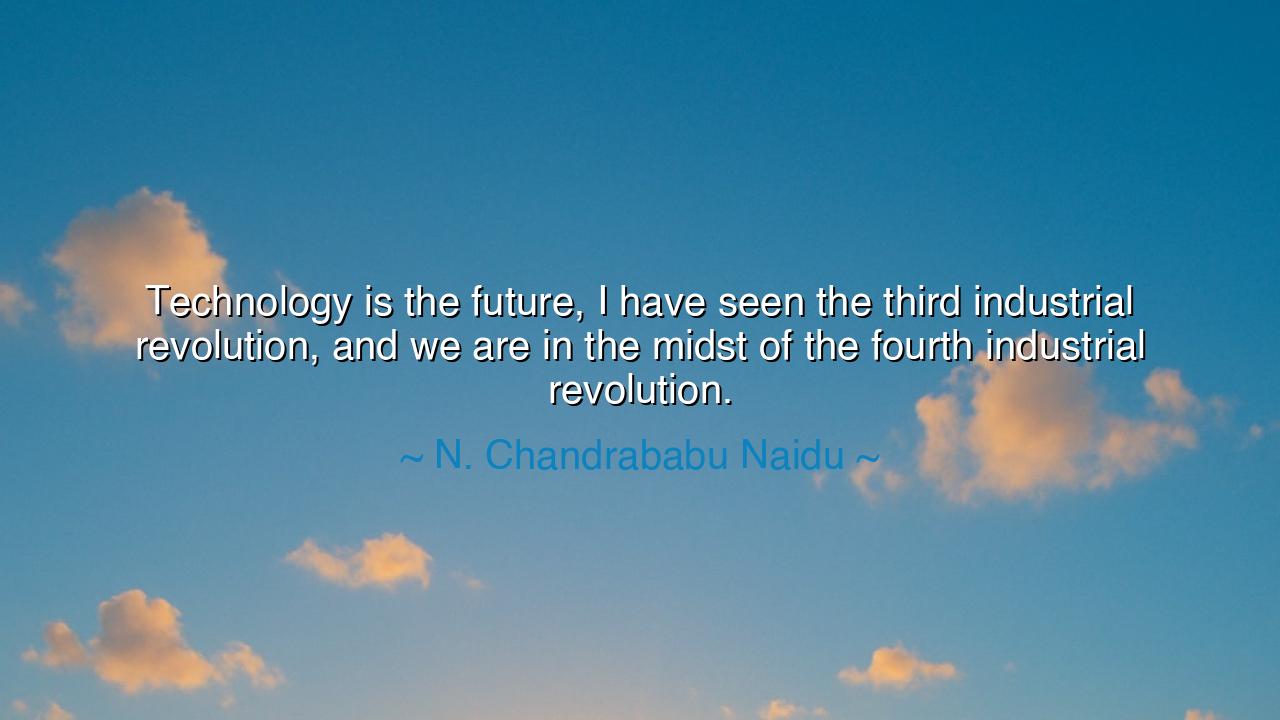
Technology is the future, I have seen the third industrial
Technology is the future, I have seen the third industrial revolution, and we are in the midst of the fourth industrial revolution.






In the unfolding tapestry of time, there comes a moment when humanity stands on the precipice of great transformation. N. Chandrababu Naidu, in his prophetic words, speaks of this transformation: "Technology is the future, I have seen the third industrial revolution, and we are in the midst of the fourth industrial revolution." These words echo through the ages, as they reflect a deeper understanding of the cyclical nature of human progress, where each era builds upon the last, creating a new world that is shaped by the technologies of the time. Naidu’s words are not just a statement of progress; they are a call to recognize the power of technology and the ever-accelerating march of innovation that defines our age.
In ancient times, civilizations were defined by their innovations—be it in agriculture, architecture, or warfare. The Egyptians with their monumental pyramids, the Greeks with their philosophical contributions, and the Romans with their roads and aqueducts, all left behind legacies that were driven by technological advances. Just as these ancient peoples reshaped the world with their creations, so too do we stand today in the midst of a new era of change. The first industrial revolution saw the birth of the steam engine, the second brought about the era of mass production, and now, the third and fourth revolutions—the digital and the technological—are shaping the future.
In the third industrial revolution, we witnessed the rise of electronics, computers, and the internet—forces that connected the world in ways that were previously unimaginable. The story of Alan Turing, whose work laid the foundation for modern computing, is a powerful illustration of how a single breakthrough can change the course of human history. Just as Turing’s ideas sparked a revolution in mathematics and technology, so too did the third revolution mark the dawn of the digital age, where information became the new currency. Naidu’s reference to having seen this revolution points to his recognition of the profound impact these changes have had on how we live, work, and communicate.
Yet, as we stand in the midst of the fourth industrial revolution, we are confronted with a new reality—a world where the boundaries between physical, digital, and biological worlds are increasingly blurred. Artificial intelligence, genetic engineering, and robotics are no longer the stuff of science fiction but the tools that define our era. The rise of automation in factories, the advent of smart cities, and the ability to harness big data are creating a landscape where change happens not in decades, but in mere years. This rapid pace of technological advancement is reshaping industries, economies, and even societies themselves, just as the agricultural revolution once did for our ancient ancestors.
The story of Henry Ford, who revolutionized the production of automobiles with the assembly line, serves as a potent reminder of how technological progress can reshape society. Ford’s vision of mass production democratized the automobile, making it accessible to millions, much as today’s technologies—from smartphones to electric cars—are democratizing access to information, transportation, and healthcare. Just as Ford’s assembly line revolutionized industry, the digital tools of today are reshaping our world, creating new industries while also making older ones obsolete.
The lesson embedded in Naidu’s words is one of awareness and adaptation. As we stand at the crossroads of these revolutions, we must recognize the power of technology in shaping our futures. Just as the ancients embraced new ideas, new tools, and new methods to advance their civilizations, so too must we embrace the opportunities offered by the fourth industrial revolution. But we must also be mindful of the responsibilities that come with this power. As the ancients taught us, progress without wisdom can lead to ruin, and technology without humanity can lead to alienation.
As individuals, we must recognize that the future is not something that happens to us, but something we actively shape. The fourth industrial revolution offers us the tools to create a better world—a world where technology can solve some of our greatest challenges, from climate change to global health to economic inequality. But to harness this power, we must not only understand the tools at our disposal but also remain grounded in the human values that define us. Let us look to the past, to the innovators and visionaries who shaped their worlds, and recognize that we too have a role to play in shaping the world of tomorrow. Through wisdom, innovation, and humanity, we can ensure that the technological future we build is one that serves not just the few, but the many.






AAdministratorAdministrator
Welcome, honored guests. Please leave a comment, we will respond soon